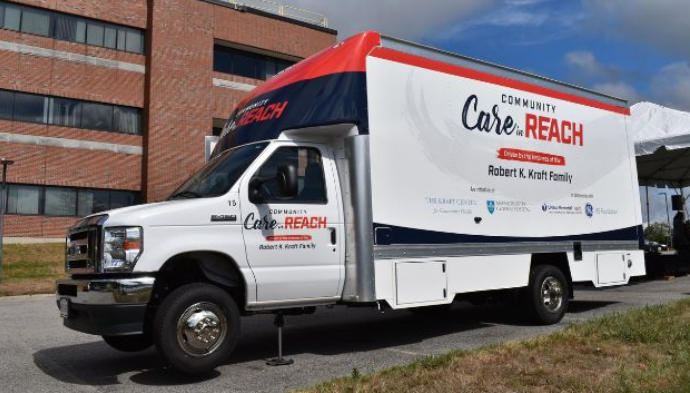The overdose epidemic is one of the nation’s most acute health crises. From 1999 to 2016, more than 630,000 people died from drug overdoses in the U.S. and 2.5 million Americans meet criteria for opioid use disorder (OUD). OUD is treatable and fatal overdose can be prevented. Studies have shown that medication for opioid use disorder (MOUD) increases the likelihood that people will stay engaged in treatment and reduces the risk of death.
Unfortunately, only 10 percent of people with OUD receive treatment and many are not connected to MOUD even following an overdose.1 Even in areas where people are within a short distance of high-quality healthcare facilities and addiction services, people still miss opportunities for treatment and overdose rates remain persistently high.

Boston is home to The Kraft Center for Community Health at Massachusetts General Hospital. In partnership with Boston Health Care for the Homeless Program, the Boston Public Health Commission’s AHOPE harm reduction program and the GE Foundation, The Kraft Center has developed an innovative mobile health program called Community Care in Reach (CCiR), the first program under The Kraft Center’s Community Care in Reach® initiative, which aims to expand access to addiction services through mobile health. This mobile health program provides low-threshold, low-barrier clinical care and harm reduction services aimed at increasing access to addiction services for people at highest risk of near-term death. Guided by precise, data-driven hotspotting, Community Care in Reach (CCiR) deploys a mobile unit and a hybrid team of clinicians and harm reduction outreach workers to areas with high rates of opioid use and overdose to engage individuals, initiate and continue MOUD treatment, provide harm reduction services and link those with OUD to long-term, comprehensive, community-based care. By mobilizing critical addiction services, clinical and harm reduction teams can bring care directly to high-risk individuals who are currently disengaged from care due to multiple barriers and stigma. Our goal is to expand on-demand access to patient-centered, compassionate care for a particularly vulnerable population.
The partnership between clinical and harm reduction providers can establish coordinated and complementary services and enhance people’s access to comprehensive care.2 The Harm Reduction Coalition defines harm reduction as “a set of practical strategies and ideas aimed at reducing negative consequences associated with drug use.” Harm reduction is also “a movement for social justice built on a belief in and respect for the rights of people who use drugs.”3 The adoption of harm reduction principles in healthcare settings can enhance clinical care by strengthening the provider-patient relationship and empowering patients to feel validated.4
The shared decision-making between the provider and patient can improve patient satisfaction, clinical results and care costs.5 By addressing the needs and desires someone self-identifies, harm reduction cultivates a service environment where people feel respected and valued. People are more willing to return to service providers when trust is built and autonomy and agency are preserved.6
Having already successfully established a program in Boston, the purpose of this manual is to serve as a guide for other programs interested in replicating the mobile health model. This toolkit outlines guidelines and protocols that may assist organizations in the planning and implementation of a mobile addiction services program that combines harm reduction and clinical care.
1 Kleber, H. (2008). Methadone maintenance 4 decades later: Thousands of lives saved but still controversial. JAMA: Journal of The American Medical Association, 300(19), 2303–2305.
2 Larochelle MR, Bernson D, Land T, Stopka T, Wang N, Xuan Z, Bagley SM, Liebschutz JM, Walley AY (2018). Medication for Opioid Use Disorder After Nonfatal Opioid Overdose and Association with Mortality. Annals of Internal Medicine, 169, 137–145.
3 Schafer, P., Calvo, M. The New York Academy of Medicine. The Integration of Harm Reduction and Healthcare: Implications and Lessons
for Healthcare Reform. 2015. https://nyam.org/media/filer_public/42/31/4231f3da-a58f-4714-ae72-23dc18616ced/harm_reduction-report_rev1119.pdf
4 “Principles of Harm Reduction.” https://harmreduction.org/about-us/ Accessed November 7, 2019.
5 Hawk, M., Coulter, R.W.S., Egan, J.E., Fisk, S., Friedman, M.R., Tula, M., Kinsky, S. Harm reduction principles for healthcare settings. Harm Reduction Journal. 2017; 14:70.
6 https://harmreductionjournal.biomedcentral.com/articles/10.1186/s12954-017-0196-4